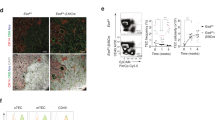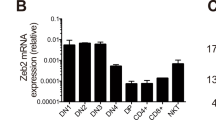Abstract
This work examines the role the lysine methyltransferase KMT1E (Setdb1) in thymocyte development. We have developed and described a T cell-specific conditional knockout of Setdb1. A partial block was seen at the double-positive to single-positive transition, causing reduced numbers of single-positive T cells in the thymus and periphery. Knockout thymocytes had reduced numbers of CD69+ and T-cell receptor TCRβ+ cells and increased numbers of apoptotic cells in the double-positive compartment, suggesting an alteration in the selection process. Transcriptional profiling of thymocytes revealed that Setdb1 deletion derepresses expression of FcγRIIb, the inhibitory Fc receptor. We demonstrate that a KMT1E-containing complex directly interacts with the FcγRIIb promoter and that histone H3 at lysine 9 tri-methylation at this promoter is dependent on Setdb1 expression. Derepression of FcγRIIb causes exacerbated signaling through the TCR complex, with specifically increased phosphorylation of ZAP70, affecting selection. This work identifies KMT1E as a novel repressor of FcγRIIb and identifies an underappreciated role of FcγRIIb in fine tuning thymocyte development.
This is a preview of subscription content, access via your institution
Access options
Subscribe to this journal
Receive 6 digital issues and online access to articles
$119.00 per year
only $19.83 per issue
Buy this article
- Purchase on Springer Link
- Instant access to full article PDF
Prices may be subject to local taxes which are calculated during checkout




Similar content being viewed by others
References
Naito T, Tanaka H, Naoe Y, Taniuchi I . Transcriptional control of T-cell development. Int Immunol 2011; 23: 661–668.
Lee PP, Fitzpatrick DR, Beard C, Jessup HK, Lehar S, Makar KW et al. A critical role for Dnmt1 and DNA methylation in T cell development, function, and survival. Immunity 2001; 15: 763–774.
Williams CJ, Naito T, Arco PG-d, Seavitt JR, Cashman SM, De Souza B et al. The chromatin remodeler Mi-2β is required for CD4 expression and T cell development. Immunity 2004; 20: 719–733.
Wilson CB, Rowell E, Sekimata M . Epigenetic control of T-helper-cell differentiation. Nat Rev Immunol 2009; 9: 91–105.
Martin C, Zhang Y . The diverse functions of histone lysine methylation. Nat Rev Mol Cell Biol 2005; 6: 838–849.
Lachner M, O'Carroll D, Rea S, Mechtler K, Jenuwein T . Methylation of histone H3 lysine 9 creates a binding site for HP1 proteins. Nature 2001; 410: 116–120.
Barski A, Cuddapah S, Cui K, Roh T-Y, Schones DE, Wang Z et al. High-Resolution Profiling of Histone Methylations in the Human Genome. Cell 2007; 129: 823–837.
Lohmann F, Loureiro J, Su H, Fang Q, Lei H, Lewis T et al. KMT1E mediated H3K9 methylation is required for the maintenance of embryonic stem cells by repressing trophectoderm differentiation. Stem Cells 2010; 28: 201–212.
Ryu H, Lee J, Hagerty SW, Soh BY, McAlpin SE, Cormier KA et al. ESET/SETDB1 gene expression and histone H3 (K9) trimethylation in Huntington's disease. Proc Natl Acad Sci 2006; 103: 19176–19181.
Dodge JE, Kang Y-K, Beppu H, Lei H, Li E . Histone H3-K9 methyltransferase ESET is essential for early development. Mol Cell Biol 2004; 24: 2478–2486.
Ceol CJ, Houvras Y, Jane-Valbuena J, Bilodeau S, Orlando DA, Battisti V et al. The histone methyltransferase SETDB1 is recurrently amplified in melanoma and accelerates its onset. Nature 2011; 471: 513–517.
Fritsch L, Robin P, Mathieu JRR, Souidi M, Hinaux H, Rougeulle C et al. A subset of the histone H3 lysine 9 methyltransferases Suv39h1, G9a, GLP, and SETDB1 participate in a multimeric complex. Mol Cell 2010; 37: 46–56.
Ait-Si-Ali S, Guasconi V, Fritsch L, Yahi H, Sekhri R, Naguibneva I et al. A Suv39h-dependent mechanism for silencing S-phase genes in differentiating but not in cycling cells. EMBO J 2004; 23: 605–615.
Lehnertz B, Northrop JP, Antignano F, Burrows K, Hadidi S, Mullaly SC et al. Activating and inhibitory functions for the histone lysine methyltransferase G9a in T helper cell differentiation and function. J Exp Med 2010; 207: 915–922.
Allan RS, Zueva E, Cammas F, Schreiber HA, Masson V, Belz GT et al. An epigenetic silencing pathway controlling T helper 2 cell lineage commitment. Nature 2012; 487: 249–253.
Thomas LR, Miyashita H, Cobb RM, Pierce S, Tachibana M, Hobeika E et al. Functional analysis of histone methyltransferase G9a in B and T lymphocytes. J Immunol 2008; 181: 485–493.
Taniuchi I, Sunshine MJ, Festenstein R, Littman DR . Evidence for distinct CD4 silencer functions at different stages of thymocyte differentiation. Mol Cell 2002; 10: 1083–1096.
Santoni de Sio FR, Barde I, Offner S, Kapopoulou A, Corsinotti A, Bojkowska K et al. KAP1 regulates gene networks controlling T-cell development and responsiveness. FASEB J 2012; 26: 4561–4575.
Zhou X-F, Yu J, Chang M, Zhang M, Zhou D, Cammas F et al. TRIM28 mediates chromatin modifications at the TCRα enhancer and regulates the development of T and natural killer T cells. Proc Natl Acad Sci 2012; 109: 20083–20088.
Chikuma S, Suita N, Okazaki I-M, Shibayama S, Honjo T . TRIM28 prevents autoinflammatory T cell development in vivo. Nat Immunol 2012; 13: 596–603.
Dodge JE, Kang YK, Beppu H, Lei H, Li E . Histone H3-K9 methyltransferase ESET is essential for early development. Mol Cell Biol 2004; 24: 2478–2486.
Wang X, Werneck MBF, Wilson BG, Kim H-J, Kluk MJ, Thom CS et al. TCR-dependent transformation of mature memory phenotype T cells in mice. J Clin Invest 2011; 121: 3834–3845.
Yamashita I, Nagata T, Tada T, Nakayama T . CD69 cell surface expression identifies developing thymocytes which audition for T cell antigen receptor-mediated positive selection. Int Immunol 1993; 5: 1139–1150.
Karimi MM, Goyal P, Maksakova IA, Bilenky M, Leung D, Tang JX et al. DNA methylation and SETDB1/H3K9me3 regulate predominantly distinct sets of genes, retroelements, and chimeric transcripts in mESCs. Cell Stem Cell 2011; 8: 676–687.
Wong QW-L, Li J, Ng SR, Lim SG, Yang H, Vardy LA . RPL39L is an example of a recently evolved ribosomal protein paralog that shows highly specific tissue expression patterns and is upregulated in ESCs and HCC tumors. RNA Biol 2014; 11: 33–41.
Sandor M, Galon J, Takacs L, Tatsumi Y, Mueller AL, Sautes C et al. An alternative Fc gamma-receptor ligand: potential role in T-cell development. Proc Natl Acad Sci 1994; 91: 12857–12861.
Daëron M, Latour S, Malbec O, Espinosa E, Pina P, Pasmans S et al. The same tyrosine-based inhibition motif, in the intra-cytoplasmic domain of FcγRIIB, regulates negatively BCR-, TCR-, and FcR-dependent cell activation. Immunity 1995; 3: 635–646.
Rodewald H-R, Moingeon P, Lucich JL, Dosiou C, Lopez P, Reinherz EL . A population of early fetal thymocytes expressing FcγRIIIII contains precursors of T lymphocytes and natural killer cells. Cell 1992; 69: 139–150.
Collazo MM, Wood D, Paraiso KHT, Lund E, Engelman RW, Le C-T et al. SHIP limits immunoregulatory capacity in the T-cell compartment. Blood 2009; 113: 2934–2944.
Jensen WA, Marschner S, Ott VL, Cambier JC . FcgammaRIIB-mediated inhibition of T-cell receptor signal transduction involves the phosphorylation of SH2-containing inositol 5-phosphatase (SHIP), dephosphorylation of the linker of activated T-cells (LAT) and inhibition of calcium mobilization. Biochem Soc Trans 2001; 29: 840–846.
Alam A, Cohen LY, Aouad S, Sékaly R-P . Early activation of caspases during T lymphocyte stimulation results in selective substrate cleavage in nonapoptotic cells. J Exp Med 1999; 190: 1879–1890.
Salek M, McGowan S, Trudgian DC, Dushek O, de Wet B, Efstathiou G et al. Quantitative phosphoproteome analysis unveils LAT as a modulator of CD3ζ and ZAP-70 tyrosine phosphorylation. PLoS ONE 2013; 8: e77423.
Schoppee Bortz PD, Wamhoff BR . Chromatin Immunoprecipitation (ChIP): revisiting the efficacy of sample preparation, sonication, quantification of sheared DNA, and analysis via PCR. PLoS ONE 2011; 6: e26015.
Veri M-C, Burke S, Huang L, Li H, Gorlatov S, Tuaillon N et al. Therapeutic control of B cell activation via recruitment of Fcγ receptor IIb (CD32B) inhibitory function with a novel bispecific antibody scaffold. Arthritis Rheum 2010; 62: 1933–1943.
Author information
Authors and Affiliations
Corresponding author
Ethics declarations
Competing interests
FJM, YX, FL, TBN, JJL and QH are employees of the Novartis Institutes of Biomedical Research.
DNC is an employee of AbbVie Inc. The remaining author declares no conflict of interest.
Additional information
Supplementary Information accompanies this paper on Genes and Immunity website
Rights and permissions
About this article
Cite this article
Martin, F., Xu, Y., Lohmann, F. et al. KMT1E-mediated chromatin modifications at the FcγRIIb promoter regulate thymocyte development. Genes Immun 16, 162–169 (2015). https://doi.org/10.1038/gene.2014.70
Received:
Revised:
Accepted:
Published:
Issue Date:
DOI: https://doi.org/10.1038/gene.2014.70



